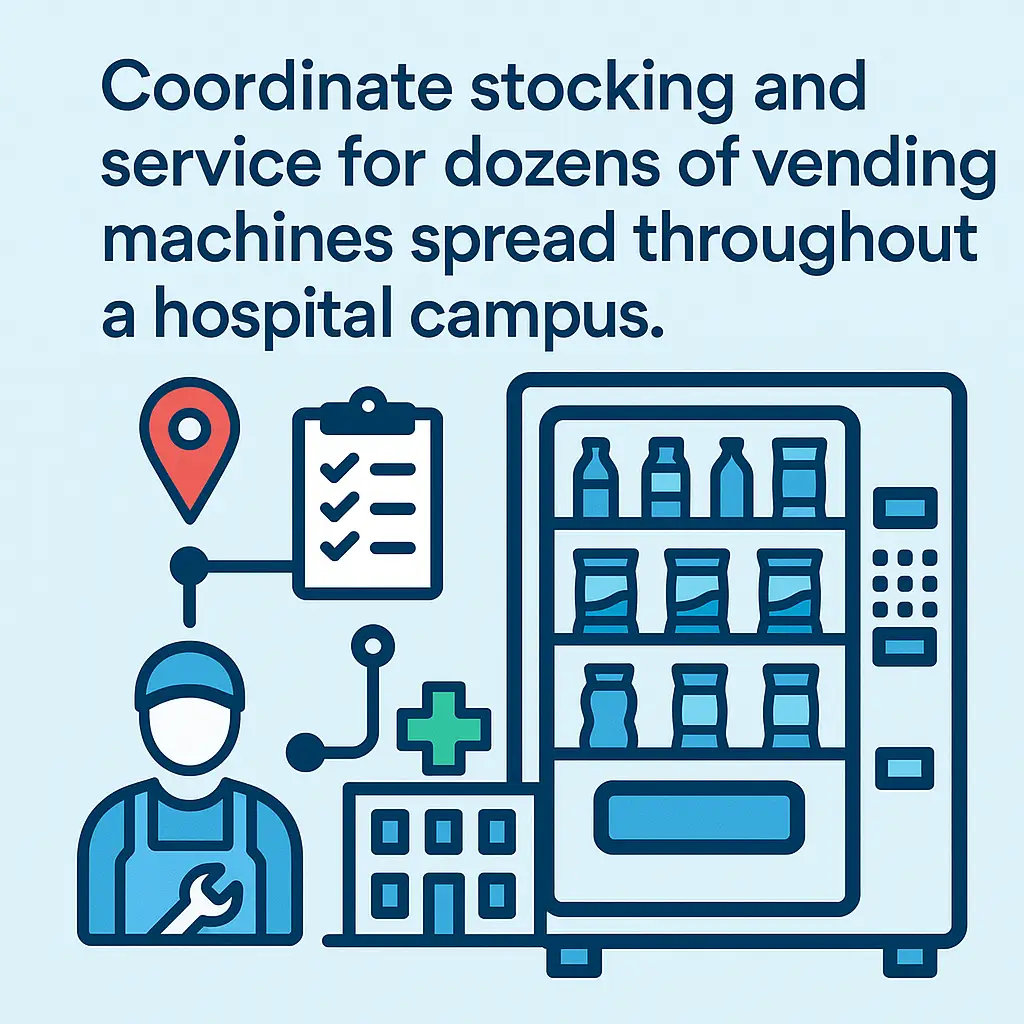Managing Multiple Vending Locations in a Hospital
Coordinate stocking and service for dozens of vending machines spread throughout a hospital campus.
Back to Vending for Healthcare ResourcesCoordinate stocking and service for dozens of vending machines spread throughout a hospital campus.
Back to Vending for Healthcare ResourcesHospitals streamline management by using scheduling systems, usage tracking, and balanced placement to keep machines stocked and service consistent across all locations.
![]() Consistent stocking prevents empty machines in critical hospital areas
Consistent stocking prevents empty machines in critical hospital areas
![]() Balanced coverage ensures equal access for staff, patients, and visitors
Balanced coverage ensures equal access for staff, patients, and visitors
![]() Tracking usage data improves efficiency across multiple hospital locations
Tracking usage data improves efficiency across multiple hospital locations

Managing dozens of vending machines across a hospital campus can be challenging without clear systems in place. Hospitals are unique environments with varied needs across staff areas, patient spaces, and visitor zones. Coordinating stocking, maintenance, and accessibility becomes essential for ensuring reliable service across multiple departments.
Large campuses demand careful planning to prevent some machines from being overused while others sit neglected. By developing rotation schedules and stocking routines, hospitals can keep machines consistently supplied. Usage data helps determine which locations need more frequent refills and which require lighter support, saving time and preventing shortages.
Strategic placement helps distribute traffic evenly. Machines in main lobbies, emergency corridors, and waiting rooms may require daily monitoring, while those in administrative wings or conference spaces may need less frequent service. Balanced distribution ensures that staff and visitors have access wherever they are, reducing bottlenecks and frustration.
Modern vending options equipped with tracking systems simplify management across multiple points. Real-time monitoring allows teams to see when machines are low on stock or experiencing issues. This reduces unnecessary checks and improves efficiency. Hospitals can use this data to fine-tune placement strategies and product selection across all locations.
Hospital staff already operate under significant pressure, so vending management must minimize disruptions. Scheduling service during off-peak hours and delegating oversight to designated roles ensures vending operations run smoothly. Coordinated oversight keeps responsibility clear and prevents issues from being overlooked.
Patients, visitors, and staff expect dependable product availability. Keeping selections consistent across departments builds reliability and trust. At the same time, localized adjustments, such as healthier options near rehab units or coffee in administrative spaces, can tailor service to specific needs.
Hospitals looking for stronger vending programs can also explore how rehabilitation-focused placements benefit recovery environments, or review insights on touchless technology in healthcare settings for improved hygiene and convenience.
If you're exploring vending options for your business, Vending Exchange can help simplify the process. Delivery, Installation and Equipment is provided at no cost to you - vendors provide the machines, keep them stocked, and handle all servicing. Whether you need a provider or full-service management, just fill out the form on this page to get started.
By using rotation schedules and monitoring usage data to guide refills.
Coordinating service, balancing traffic flow, and maintaining product availability are key challenges.
Placement is based on foot traffic, convenience, and accessibility for staff and visitors.
Yes, tracking tools show usage patterns, helping optimize service schedules and placement.
Emergency areas, lobbies, and waiting rooms require the most frequent attention.
By aligning service schedules with demand and using smart monitoring technology.
Balanced distribution prevents overcrowding in busy areas and neglect in quiet ones.
Staff help oversee machine condition but rely on scheduled service for stocking.
Yes, selections can be customized for areas like rehab units or staff lounges.
By assigning oversight roles and scheduling routine service checks to prevent downtime.